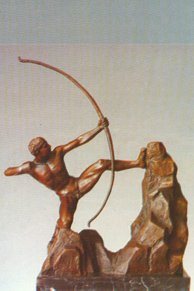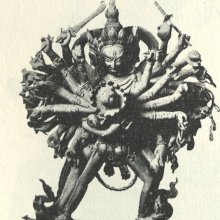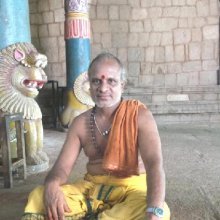Dhanus, Dhanur, Dhanush: 28 definitions
Introduction:
Dhanus means something in Buddhism, Pali, Hinduism, Sanskrit, Jainism, Prakrit, Hindi. If you want to know the exact meaning, history, etymology or English translation of this term then check out the descriptions on this page. Add your comment or reference to a book if you want to contribute to this summary article.
Images (photo gallery)
In Hinduism
Purana and Itihasa (epic history)
Source: Google Books: Cultural History from the Vāyu PurānaDhanu (धनु): A unit of measurement of distance, according to the Vāyu Purāṇa (वायु पुराण). The following table gives some idea about their relations to each other:
|
8 Aṅgulas = Prādeśa (?); 21 Aṅgulas = Ratni; 24 Aṅgulas = Hasta; 2000 Dhanus = Gavyūti; |
12 Aṅgulas = Vitasti; 2 Ratnis or 42 Aṅgulas = Kiṣku; 4 hastas = Dhanus; 8000 Dhanus = Yojana. |

The Purana (पुराण, purāṇas) refers to Sanskrit literature preserving ancient India’s vast cultural history, including historical legends, religious ceremonies, various arts and sciences. The eighteen mahapuranas total over 400,000 shlokas (metrical couplets) and date to at least several centuries BCE.
Shilpashastra (iconography)
Source: Google Books: Elements of Hindu iconographyDhanus is the bow. It has three different shapes. The first is like an arc of a circle, with the ends joined by a string or thong taking the place of the chord. In the second variety, it has three bends, the top and bottom bends being smaller and turned in a direction opposite to that of the middle bend which is the larger one. The third variety has five bends and belongs to a much later period in the evolution of this weapon.
Source: Shodhganga: The significance of the mūla-beras (śilpa)1) Dhanus (धनुस्, “bow”) refers to one of the several “attributes” (āyudha) or “accessories” of a detiy commonly seen depicted in Hindu iconography, defined according to texts dealing with śilpa (arts and crafs), known as śilpaśāstras.—Dhanus is the bow. It has three different shapes. The first is like an arc of arc of a circle, with the ends joined by a string or thong taking the place of the chord. In the second variety, it has three bends, the top and bottom bends being smaller and turned in a direction opposite to that of the middle bend which is the larger one. The third variety has five bends.
2) Dhanus (धनुस्) or Dhanurhasta refers to “bow-hold” and represents one of the twenty-four gestures with a single hand, as defined according to texts dealing with śilpa (arts and crafs), known as śilpaśāstras.—Accordingly, pratimā-lakṣaṇa (body postures of the icons) is comprised of hand gestures (hasta, mudrā or kai-amaiti), stances/poses (āsanas) and inflexions of the body (bhaṅgas). There are thirty-two types of hands [viz., dhanus-hasta] classified into two major groups known as tolirkai (functional and expressive gestures) and elirkai (graceful posture of the hand).

Shilpashastra (शिल्पशास्त्र, śilpaśāstra) represents the ancient Indian science (shastra) of creative arts (shilpa) such as sculpture, iconography and painting. Closely related to Vastushastra (architecture), they often share the same literature.
Natyashastra (theatrics and dramaturgy)
Source: Wisdom Library: Nāṭya-śāstraDhanus (धनुस्, “bow”).—There are four acts related to the (use of the) bow, according to the Nāṭyaśāstra chapter 11.
- parimārjana (preparing),
- ādāna (taking an arrow),
- sandhāna (taking an aim),
- mokṣaṇa (shooting).
The dhanus (“bow”) should measure should measure eight tālas (unit of measurement) and the distance between the bow and the string at the time of shooting should be 2 hastakas, according to Nāṭyaśāstra chapter 23. In dramatic plays, weapons such as dhanus should be made by experts using proper measurements and given to persons engaged in a fight, angry conflict or siege. It forms a component of āhāryābhinaya (extraneous representation).

Natyashastra (नाट्यशास्त्र, nāṭyaśāstra) refers to both the ancient Indian tradition (shastra) of performing arts, (natya—theatrics, drama, dance, music), as well as the name of a Sanskrit work dealing with these subjects. It also teaches the rules for composing Dramatic plays (nataka), construction and performance of Theater, and Poetic works (kavya).
Dhanurveda (science of warfare)
Source: Wisdom Library: DhanurvedaDhanus (धनुस्) refers to a weapon (“bow”). It is a Sanskrit word defined in the Dhanurveda-saṃhitā, which contains a list of no less than 117 weapons. The Dhanurveda-saṃhitā is said to have been composed by the sage Vasiṣṭha, who in turn transmitted it trough a tradition of sages, which can eventually be traced to Śiva and Brahmā.

Dhanurveda (धनुर्वेद) refers to the “knowledge of warfare” and, as an upaveda, is associated with the Ṛgveda. It contains instructions on warfare, archery and ancient Indian martial arts, dating back to the 2nd-3rd millennium BCE.
Vastushastra (architecture)
Source: Wisdom Library: Vāstu-śāstraDhanus (धनुस्) corresponds with the Sagittarius zodiac sign and refers to the ninth of twelve rāśi (zodiacal sign), according to the Mānasāra. Rāśi is one of the three alternative principles, besides the six āyādiṣaḍvarga, used to constitute the “horoscope” of an architectural or iconographic object. Their application is intended to “verify” the measurements of the architectural and iconographic object against the dictates of astrology that lay out the conditions of auspiciousness.
The particular rāśi (e.g., dhanus) of all architectural and iconographic objects (settlement, building, image) must be calculated and ascertained. This process is based on the principle of the remainder. An arithmetical formula to be used in each case is stipulated, which engages one of the basic dimensions of the object (breadth, length, or perimeter/circumference). All twelve rāśis, except the eighth (vṛścika) are auspicious.
Source: Brill: Śaivism and the Tantric Traditions (architecture)Dhanus (धनुस्) refers to a “bow” (weapon), according to the Piṅgalāmata (verse 10.93-128).— Accordingly, [while describing the pura on a 9-by-9-plan and the 32 padas]—“At Gṛhakṣata one should set up [a storeroom for] bows (dhanus), arrows, swords, and other weapons. At Yama there should be a place for ascetics to achieve contemplation of the self. Singers are stationed at Gandharva. At Bhṛṅga is a hall for the exposition [of the śāstras]. Or one may construct a large maṭha on the four [positions] which are Gṛhakṣata and [Yama, Gandharva and Bhṛṅga]”.

Vastushastra (वास्तुशास्त्र, vāstuśāstra) refers to the ancient Indian science (shastra) of architecture (vastu), dealing with topics such architecture, sculpture, town-building, fort building and various other constructions. Vastu also deals with the philosophy of the architectural relation with the cosmic universe.
Vaishnavism (Vaishava dharma)
Source: Pure Bhakti: Arcana-dipika - 3rd EditionDhanur (धनुर्) corresponds to “sagittarius” (mid December to mid January) and refers to one of the zodiac signs (rāśī) in the Vedic calendar.—Rāśī refers to the different signs of the zodiac through which the sun travels. For precise dates, please refer to a Vedic calendar. In accordance with the zodiac sign the sun is situated in, one would utter [for example, dhanur-rāśī sthite bhāskare]

Vaishnava (वैष्णव, vaiṣṇava) or vaishnavism (vaiṣṇavism) represents a tradition of Hinduism worshipping Vishnu as the supreme Lord. Similar to the Shaktism and Shaivism traditions, Vaishnavism also developed as an individual movement, famous for its exposition of the dashavatara (‘ten avatars of Vishnu’).
Shaktism (Shakta philosophy)
Source: Google Books: ManthanabhairavatantramDhanus (धनुस्) (Cf. Cāpa) refers to “bows”, according to the Ṣaṭsāhasrasaṃhitā, an expansion of the Kubjikāmatatantra: the earliest popular and most authoritative Tantra of the Kubjikā cult.—Accordingly, “[...] O goddess, I will (now) tell you about the god of Kāmarūpa. (His) city is fashioned all around with pillars of sapphire. It has palaces, mansions, arches, banners, goads, and bows [i.e., prāsāda-toraṇa-aṭṭāla-dhvaja-aṅkuśa-dhanus-dhara]. The god holds five arrows and is accompanied by Kāmeśvarī. Without a body and in the form of light, he melts away the entire universe. He is the lord of the fourteen worlds and holds the staff (of authority). Everything, including passion and the rest, takes place impelled by his will. Thus, it is located in the foremost portion, above Mind Beyond Mind. O Pārvatī, one should meditate on it above the Cavity of Brahmā within the End of the Twelve”.
Source: Brill: Śaivism and the Tantric Traditions (shaktism)Dhanus (धनुस्) refers to a “bow”, according to the King Vatsarāja’s Pūjāstuti called the Kāmasiddhistuti (also Vāmakeśvarīstuti), guiding one through the worship of the Goddess Nityā.—Accordingly, “[...] I worship those compassionately-disposed goddesses of red-complexion, the eight powers of the bodiless [love-god Kāmadeva], who have arisen like shadows of the goddess [Nityā Sundarī] and are very difficult to conquer. I venerate those fourteen goddesses, with Sarvasaṃkṣobhaṇī at the fore, to whom [all] fourteen worlds bow. They carry a bow and arrows (bāṇa-dhanus) made of sugarcane. [...]”.

Shakta (शाक्त, śākta) or Shaktism (śāktism) represents a tradition of Hinduism where the Goddess (Devi) is revered and worshipped. Shakta literature includes a range of scriptures, including various Agamas and Tantras, although its roots may be traced back to the Vedas.
Sports, Arts and Entertainment (wordly enjoyments)
Source: archive.org: Syainika Sastra of Rudradeva with English Translation (art)Dhanur (धनुर्) refers to “archers” (employed during hunting), according to the Śyainika-śāstra: a Sanskrit treatise dealing with the divisions and benefits of Hunting and Hawking, written by Rājā Rudradeva (or Candradeva) in possibly the 13th century.—Accordingly, “Hunting on horseback (āśvina) represents one of the eight subdivisions of Hunting (mṛgayā). [...] Five or six horsemen are quite enough for hunting rhinoceros. [...] If it turns back, then the horseman relying on the dexterity of his horse should at once run in its front; others should hit it from behind or skilled archers (śreṣṭha-dhanur) should pierce it with arrows on the sides. [...]”.

This section covers the skills and profiencies of the Kalas (“performing arts”) and Shastras (“sciences”) involving ancient Indian traditions of sports, games, arts, entertainment, love-making and other means of wordly enjoyments. Traditionally these topics were dealt with in Sanskrit treatises explaing the philosophy and the justification of enjoying the pleasures of the senses.
General definition (in Hinduism)
Source: archive.org: Vedic index of Names and SubjectsDhanus (धनुस्, the ‘bow’), frequently mentioned in the Rigveda and later, was the chief weapon of the Vedic Indian. The last act of the funeral rite included the removal of the bow from the right hand of the dead man. The weapon was composed of a stout staff bent into a curved shape (vakra),5 and of a bowstring (Jyā) made of a strip of cowhide6 which joined the ends. The tips of the bow, when the string was fastened, were called Ārtnī. Relaxed when not in actual use, the bow was specially strung up when needed for shooting. The stages of the process are given in detail in the Vājasaneyi-saṃhitā: the stringing (ātan) of the bow, the placing (pratidhā) of the arrow, the bending (āyam) of the bow, and the shooting (as). The arrow was discharged from the ear, and is hence called karṇa-yoni, ‘having the ear as its point of origin’. The making of bows was a regular profession (dhanuṣkāra, dhanuṣkṛt). For the arrow see Iṣu, and for the handguard Hastaghna.
In Buddhism
Tibetan Buddhism (Vajrayana or tantric Buddhism)
Source: Wisdom Library: Tibetan BuddhismDhanus (धनुस्) is the name of a Rāśi (zodiac sign) mentioned as attending the teachings in the 6th century Mañjuśrīmūlakalpa: one of the largest Kriyā Tantras devoted to Mañjuśrī (the Bodhisattva of wisdom) representing an encyclopedia of knowledge primarily concerned with ritualistic elements in Buddhism. The teachings in this text originate from Mañjuśrī and were taught to and by Buddha Śākyamuni in the presence of a large audience (including Dhanus).
Source: academia.edu: The Structure and Meanings of the Heruka MaṇḍalaDhanus (धनुस्) refers to a “bow” and represents one of the items held in the left hand of Heruka: one of the main deities of the Herukamaṇḍala described in the 10th century Ḍākārṇava chapter 15. Heruka is positioned in the Lotus (padma) at the center; He is the origin of all heroes; He has 17 faces (with three eyes on each) and 76 arms [holding, for example, dhanus]; He is half black and half green in color; He is dancing on a flaming sun placed on Bhairava and Kālarātrī.

Tibetan Buddhism includes schools such as Nyingma, Kadampa, Kagyu and Gelug. Their primary canon of literature is divided in two broad categories: The Kangyur, which consists of Buddha’s words, and the Tengyur, which includes commentaries from various sources. Esotericism and tantra techniques (vajrayāna) are collected indepently.
Mahayana (major branch of Buddhism)
Source: Wisdom Library: Maha Prajnaparamita SastraDhanus (धनुस्) refers to a “bow”, according to Mahāprajñāpāramitāśāstra (chapter 4).—Accordingly, “[Question: Why is the Buddha called Arhat?]—[Answer]: Ara means enemy (ari) and hat means to kill (han). The expression therefore means ‘killer of enemies’. Some stanzas say: ‘The Buddha has patience (kṣānti) as his armor (varman), Energy (vīrya) as his helmet (śīrṣaka), Discipline (śīla) as his great steed (mahāśva), Dhyāna as his bow (dhanus), Wisdom (prajñā) as his arrows (śara). Outwardly, he destroys the army of Māra (mārasena). Inwardly, he destroys the passions (kleśa), his enemies. He is called Arhat. [...]’.

Mahayana (महायान, mahāyāna) is a major branch of Buddhism focusing on the path of a Bodhisattva (spiritual aspirants/ enlightened beings). Extant literature is vast and primarely composed in the Sanskrit language. There are many sūtras of which some of the earliest are the various Prajñāpāramitā sūtras.
In Jainism
General definition (in Jainism)
Source: OpenEdition books: VividhatīrthakalpaḥDhanus (धनुस्) refers to a unity of measurement corresponding to 4 hasta (2 m.), and represents a Jaina technical term mentioned in the Vividhatīrthakalpa by Jinaprabhasūri (13th century A.D.): an ancient text devoted to various Jaina holy places (tīrthas).

Jainism is an Indian religion of Dharma whose doctrine revolves around harmlessness (ahimsa) towards every living being. The two major branches (Digambara and Svetambara) of Jainism stimulate self-control (or, shramana, ‘self-reliance’) and spiritual development through a path of peace for the soul to progess to the ultimate goal.
Languages of India and abroad
Pali-English dictionary
Source: BuddhaSasana: Concise Pali-English Dictionarydhanu : (nt.) a bow.

Pali is the language of the Tipiṭaka, which is the sacred canon of Theravāda Buddhism and contains much of the Buddha’s speech. Closeley related to Sanskrit, both languages are used interchangeably between religions.
Sanskrit dictionary
Source: DDSA: The practical Sanskrit-English dictionaryDhanus (धनुस्).—a. [dhan śabde-asi] Armed with a bow. n.
1) A bow; धनुर्वंशविशुद्धोऽपि निर्गुणः किं करिष्यति (dhanurvaṃśaviśuddho'pi nirguṇaḥ kiṃ kariṣyati) Subhāṣ. धनुष्यमोघं समधत्त बाणम् (dhanuṣyamoghaṃ samadhatta bāṇam) Kumārasambhava 3.66; so इन्द्रधनुः (indradhanuḥ) &c. (At the end of Bahu. comp. dhanus is changed to dhanvan; adhijyadhanvā vicacāra dāvam R.2.8.).
2) A measure of length equal to four hastas; धनुःशतं परीणाहो ग्रामे क्षेत्रान्तरं भवेत् (dhanuḥśataṃ parīṇāho grāme kṣetrāntaraṃ bhavet) Y.2.167; Ms. 8.237.
3) An arc of a circle.
4) The sign Sagittarius of the zodiac.
5) A desert; cf. धन्वन् (dhanvan) -m. Name of Śiva.
Source: Cologne Digital Sanskrit Dictionaries: Shabda-Sagara Sanskrit-English DictionaryDhanus (धनुस्).—mfn. (-nuḥ-nuḥ-nu) Armed with a bow. mn. (-nuḥ-nu) 1. A. bow. 2. Sagittarius, the sign. m.
(-nuḥ) The piyal tree, (Buchanania latifolia, Rox.) E. dhana to produce, (as grain,) to throw forth, (darts, &c.) Unadi affix usi; also with u affix dhanu, and with ū affix, dhanū.
Source: Cologne Digital Sanskrit Dictionaries: Benfey Sanskrit-English DictionaryDhanus (धनुस्).— i. e. probably han + vant (akin to dhanvan), I. adj. Armed with a bow, Mahābhārata 7, 9536. Ii. n. 1. A bow, [Mānavadharmaśāstra] 3, 160. 2. A measure of length, [Mānavadharmaśāstra] 8, 237. 3. The sign Sagittarius. 4. A desert, [Mānavadharmaśāstra] 7, 70 (cf. dhanvan).
Source: Cologne Digital Sanskrit Dictionaries: Cappeller Sanskrit-English DictionaryDhanus (धनुस्).—[neuter] bow or a bow’s length (a cert. measure).
Source: Cologne Digital Sanskrit Dictionaries: Monier-Williams Sanskrit-English DictionaryDhanur (धनुर्):—[from dhanu] in [compound] for nus.
Source: Cologne Digital Sanskrit Dictionaries: Monier-Williams Sanskrit-English Dictionary1) Dhanuṣ (धनुष्):—[from dhanu] in [compound] for nus.
2) Dhanus (धनुस्):—[from dhanu] n. (m. [gana] ardharcādi; cf. dhanu) a bow, [Ṛg-veda] etc. etc.
3) [v.s. ...] a measure of length = 4 Hastas or 1/2000 Gavyūti, [Manu-smṛti; Yājñavalkya] etc.
4) [v.s. ...] ([geometry]) an arc or part of a circle
5) [v.s. ...] ([astronomy]) an arc or quadrant for ascertaining the sun’s altitude and zenith-distance
6) [v.s. ...] a fiddlestick
7) [v.s. ...] the sign of the zodiac Sagittarius, [Sūryasiddhānta; Varāha-mihira]
8) [v.s. ...] Buchanania Latifolia, [cf. Lexicographers, esp. such as amarasiṃha, halāyudha, hemacandra, etc.]
9) [v.s. ...] Name of Śiva, [Mahābhārata vii, 9536] (armed with a bow, [cf. Lexicographers, esp. such as amarasiṃha, halāyudha, hemacandra, etc.], or = dhanuḥsvarūpa, [Nīlakaṇṭha])
10) [v.s. ...] a desert, arid land (cf. nur-aur. ga).
Source: Cologne Digital Sanskrit Dictionaries: Yates Sanskrit-English DictionaryDhanus (धनुस्):—[(nuḥ-nuḥ)] 5. m. n. A bow; Sagittarius. m. The Piyāl tree. a. Armed with a bow.
Source: DDSA: Paia-sadda-mahannavo; a comprehensive Prakrit Hindi dictionary (S)Dhanuṣ (धनुष्) in the Sanskrit language is related to the Prakrit word: Dhaṇu.
[Sanskrit to German]
Sanskrit, also spelled संस्कृतम् (saṃskṛtam), is an ancient language of India commonly seen as the grandmother of the Indo-European language family (even English!). Closely allied with Prakrit and Pali, Sanskrit is more exhaustive in both grammar and terms and has the most extensive collection of literature in the world, greatly surpassing its sister-languages Greek and Latin.
Hindi dictionary
Source: DDSA: A practical Hindi-English dictionaryDhanush in Hindi refers in English to:—(nm) a bow, an arch..—dhanush (धनुष) is alternatively transliterated as Dhanuṣa.
...
See also (Relevant definitions)
Starts with (+50): Dhanuhasta, Dhanuhshrama, Dhanuhstambha, Dhanurakara, Dhanurasana, Dhanurastra, Dhanurbana, Dhanurbhaga, Dhanurbhrit, Dhanurdhara, Dhanurghanta, Dhanurgraha, Dhanurguna, Dhanurlata, Dhanurmaha, Dhanurmushti, Dhanurveda, Dhanurvedin, Dhanurvidya, Dhanusaksha.
Ends with (+12): Aindradhanus, Akhandaladhanus, Banadhanus, Brihaddhanus, Cakradhanus, Chakradhanus, Dashadhanus, Dhritadhanus, Dridhadhanus, Grihitadhanus, Hiranyadhanus, Indradhanus, Kusumadhanus, Mahadhanus, Manidhanus, Navatidhanus, Pancadhanus, Panchadhanus, Pushpadhanus, Rohitendradhanus.
Full-text (+271): Dhanu, Dhanurbhrit, Dhanushkara, Dhanushpani, Dhanushka, Dhanurdhara, Dhanurgraha, Dhanurmarga, Dhanurmadhya, Manidhanus, Dhanurguna, Dhanurmala, Dhanurvriksha, Dhanutkapala, Dhanushkrit, Suradhanus, Dhanurdruma, Dhanurdharin, Dhanurvidya, Dhanushpata.
Relevant text
Search found 61 books and stories containing Dhanus, Dhanur, Dhanuṣ, Dhanush; (plurals include: Dhanuses, Dhanurs, Dhanuṣs, Dhanushes). You can also click to the full overview containing English textual excerpts. Below are direct links for the most relevant articles:
Garga Samhita (English) (by Danavir Goswami)
Verse 4.19.92 < [Chapter 19 - A Thousand Names of Srī Yamunā]
Verse 6.19.21 < [Chapter 19 - In the First Fortress of Dvārakā, the Glories of Līlā-sarovara, etc.]
Verse 6.7.9 < [Chapter 7 - The Marriage of Śrī Rukmiṇī]
Vastu-shastra (2): Town Planning (by D. N. Shukla)
Early Chola Temples (by S. R. Balasubrahmanyam)
Temples in Mayuram (Tiru-Mayiladuturai) < [Chapter VIII - Temples of Uttama Chola’s Time]
Temples in Kamarasavalli < [Chapter IV - Temples of Sundara Chola’s Time]
Nitiprakasika (Critical Analysis) (by S. Anusha)
Dhanus (Bow) < [Chapter 3]
Instructions for the King < [Chapter 5]
War Weapons (2): Astras (Introduction) < [Chapter 3]
The Devi Bhagavata Purana (by Swami Vijñanananda)
Chapter 37 - On the eighty-six Kuṇḍas and their characteristics < [Book 9]
Chapter 23 - On the killing of Śaṅkhacūḍa < [Book 9]
Chapter 29 - On the anecdote of Sāvitrī, on gifts and on the effects of Karmas < [Book 9]
Bhakti-rasamrta-sindhu (by Śrīla Rūpa Gosvāmī)
Verse 2.4.77 < [Part 4 - Transient Ecstatic Disturbances (vyābhicāri-bhāva)]
Verse 2.1.317 < [Part 1 - Ecstatic Excitants (vibhāva)]
Verse 3.3.115 < [Part 3 - Fraternal Devotion (sakhya-rasa)]
Related products



